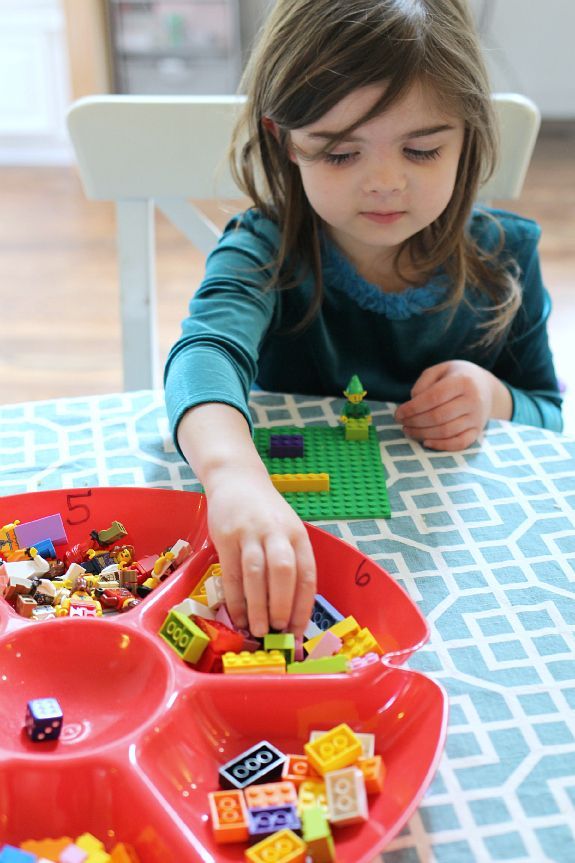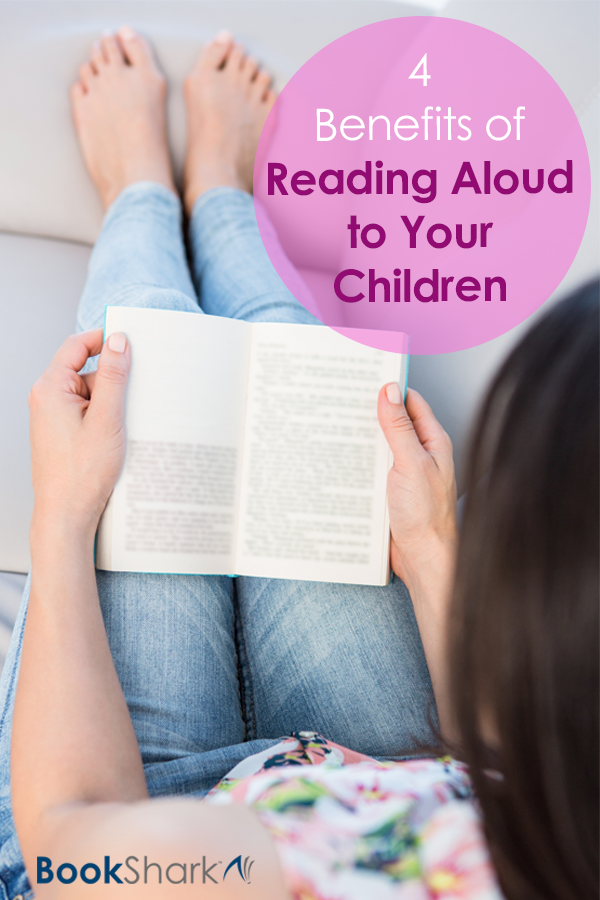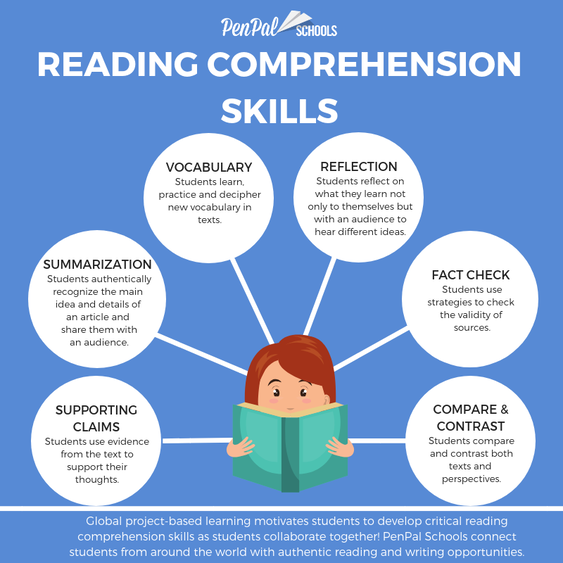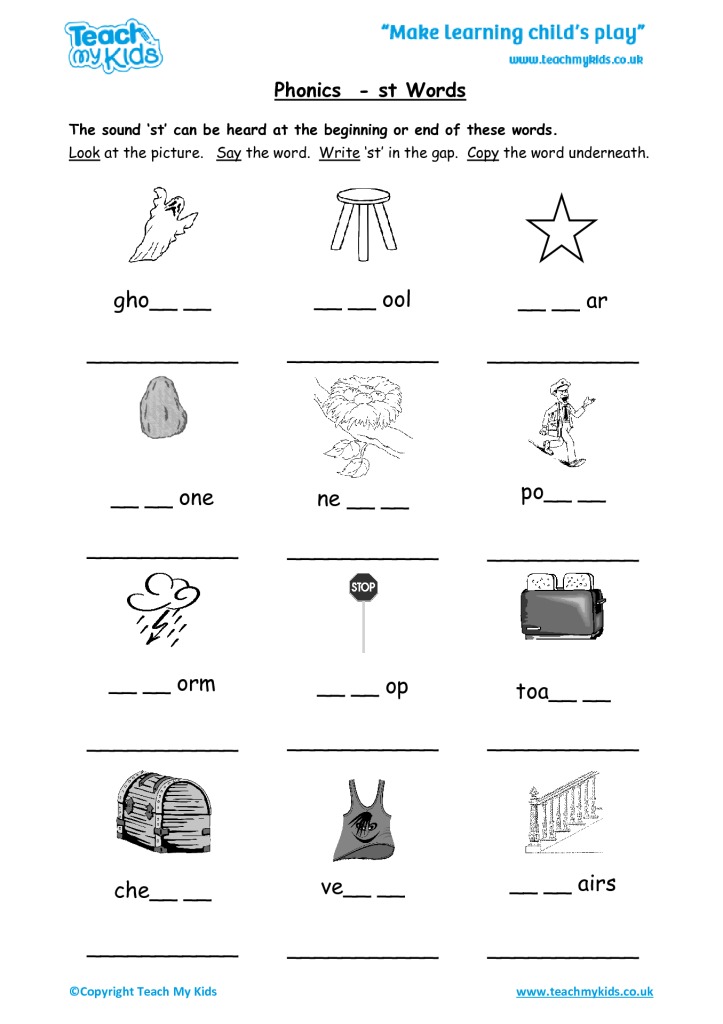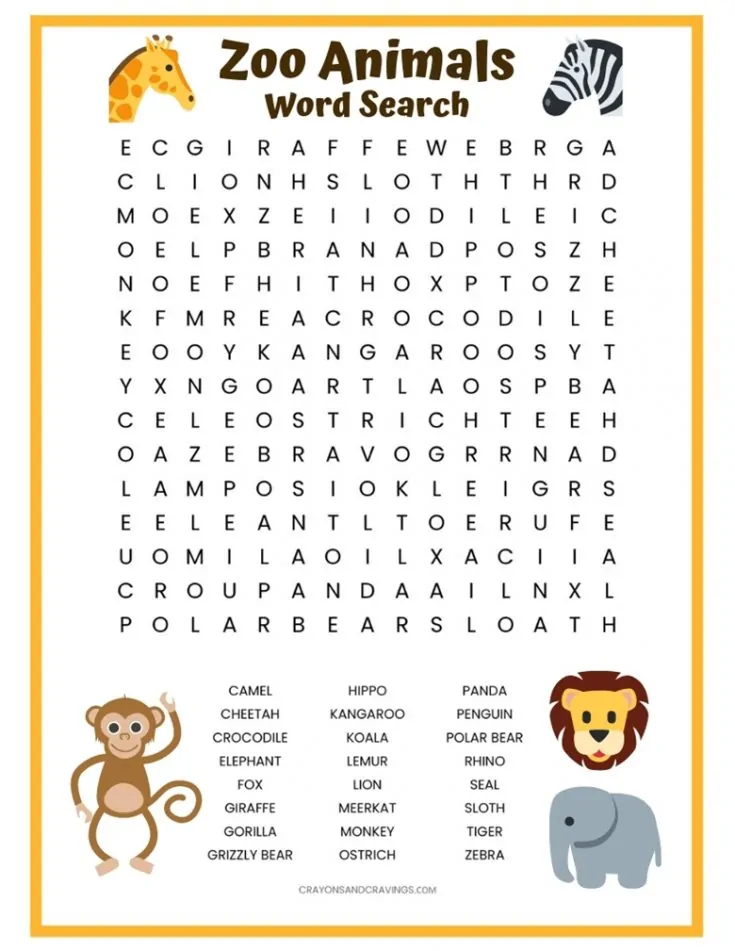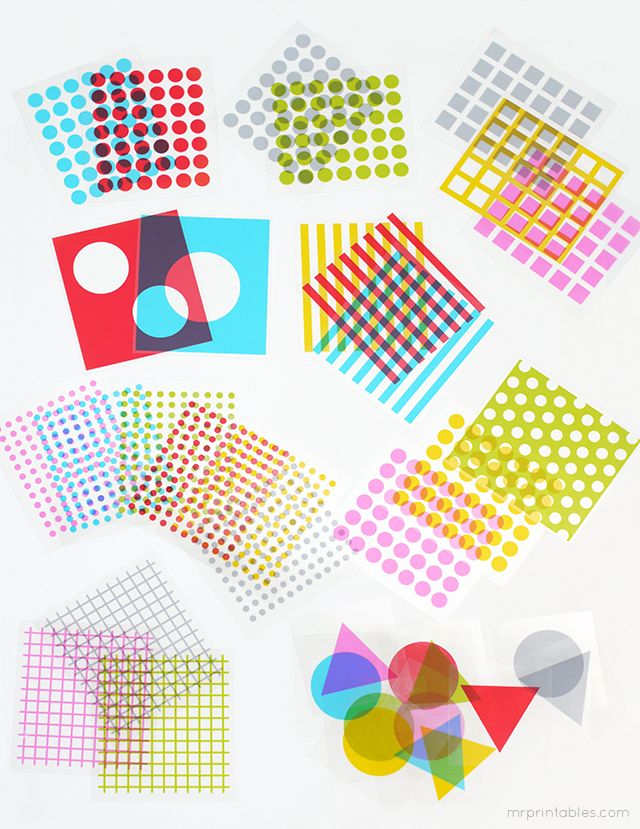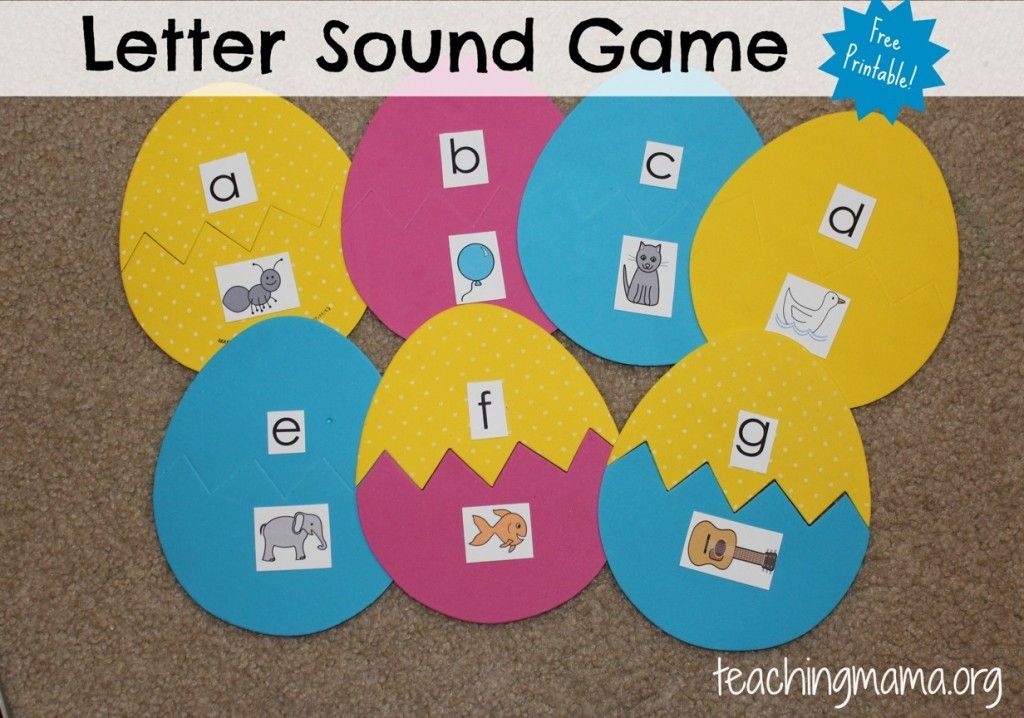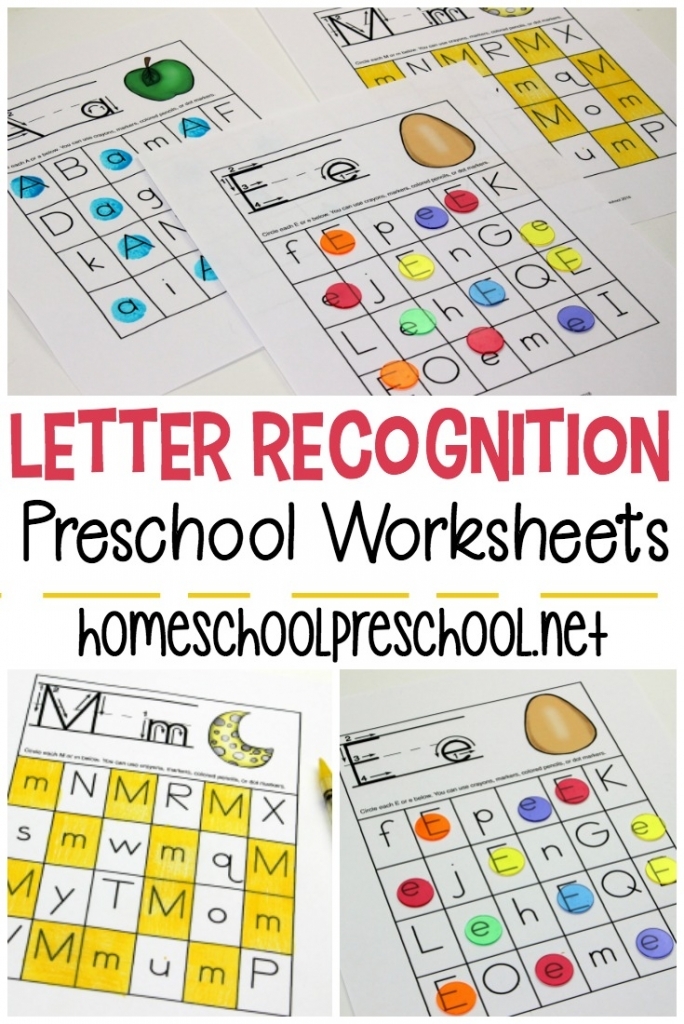Developing phonological awareness
Ways to Build Phonological Awareness in Pre-K and Kindergarten
There are a few ways kids in pre-K and kindergarten can get ready to read. One way is by noticing and playing with the words, rhymes, and syllables they hear in everyday speech. This called phonological awareness.
Kids also start to tune in to the individual sounds or phonemes in words. This is called phonemic awareness. The more you can build on these early “pre-reading” skills, the more prepared your child will be for the challenge of learning to read.
1. Listen up.
Good phonological awareness starts with kids picking up on sounds, syllables and rhymes in the words they hear. Read aloud to your child frequently. Choose books that rhyme or repeat the same sound. Draw your child’s attention to rhymes: “Fox, socks, box! Those words all rhyme. Do you hear how they almost sound the same?”
It also helps to point out repeated sounds. For example, if you’re reading One Fish, Two Fish, Red Fish, Blue Fish, ask your child to listen to the /fffff/ sound in fish. (Really stretch the sounds out at first.) Outside of story time, try pointing out other words that start with the /fffff/ sound, just like in the book.
2. Focus on rhyming.
Ask your child to pick out the rhyming words in books without your help. Ask, “Did you hear a word that rhymes with fox?” Teach your child nursery rhymes and practice saying them together. Or say four short words, like log, cat, hog, frog. See if your child can pick out the word that doesn’t rhyme.
3. Follow the beat.
Make syllables easier to understand by clapping the “beats” your child hears in words. Let’s say you choose the word elephant. Pause as you say each syllable — e-le-phant — and clap out each syllable together. You can also get your child up and moving by having your child stomp or jump with each syllable.
4. Get into guesswork.
Guessing games such as “I spy” can be used to work on almost any phonological skill. Want to practice noticing what sounds word begin with? Try “I spy something red that starts with /s/.” Want to work on rhymes? “I’m wearing something warm that rhymes with
boat.”
Want to practice noticing what sounds word begin with? Try “I spy something red that starts with /s/.” Want to work on rhymes? “I’m wearing something warm that rhymes with
boat.”
5. Carry a tune.
Singing in general is a great way to get kids rhyming. There are also good songs teachers use to focus on other kinds of phonological and phonemic awareness skills. “Apples and Bananas” is a fun one. You can search online for more songs about phonemic awareness or ask your child’s teacher for recommendations.
6. Connect the sounds.
Sound blending is an important skill for early readers. They need to put sound units — phonemes — together to be able to read a word smoothly. You can help your child start working on this by putting together sounds of different words. Ask your child to connect the beginning sound with the rest of a word. For example, say, “Start with /p/ and add /ig/. What do word do you hear if you put them together?”
7. Break apart words.
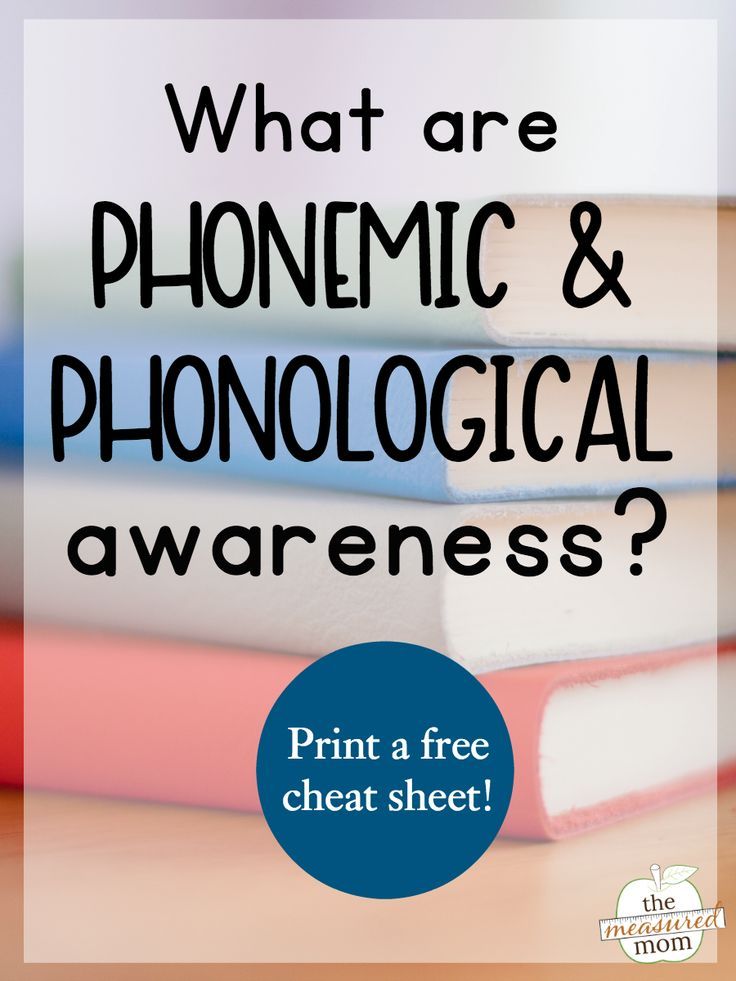
Have your child work on hearing a word and taking it apart. Start by using compound words such as cowboy, baseball or firefly. Tell your child, “Say the word cowboy. Now take away boy. What word is left?”
You can also use LEGO bricks to make this point. Give your child two attached LEGO bricks to represent parts of the word. Then have your child physically take the LEGO pieces apart while removing part of the word.
8. Get creative with crafts.
Kids respond to hands-on learning. Try making a collage of items that start with the same sound using pictures from magazines. Sock puppets can be another fun way to work on these skills. Make one that likes to munch on words that start with a certain sound. Let your child have fun “feeding” the puppet different objects or pictures that start with that sound.
9. Search online.
There are many resources and ideas online to work on phonological and phonemic awareness skills.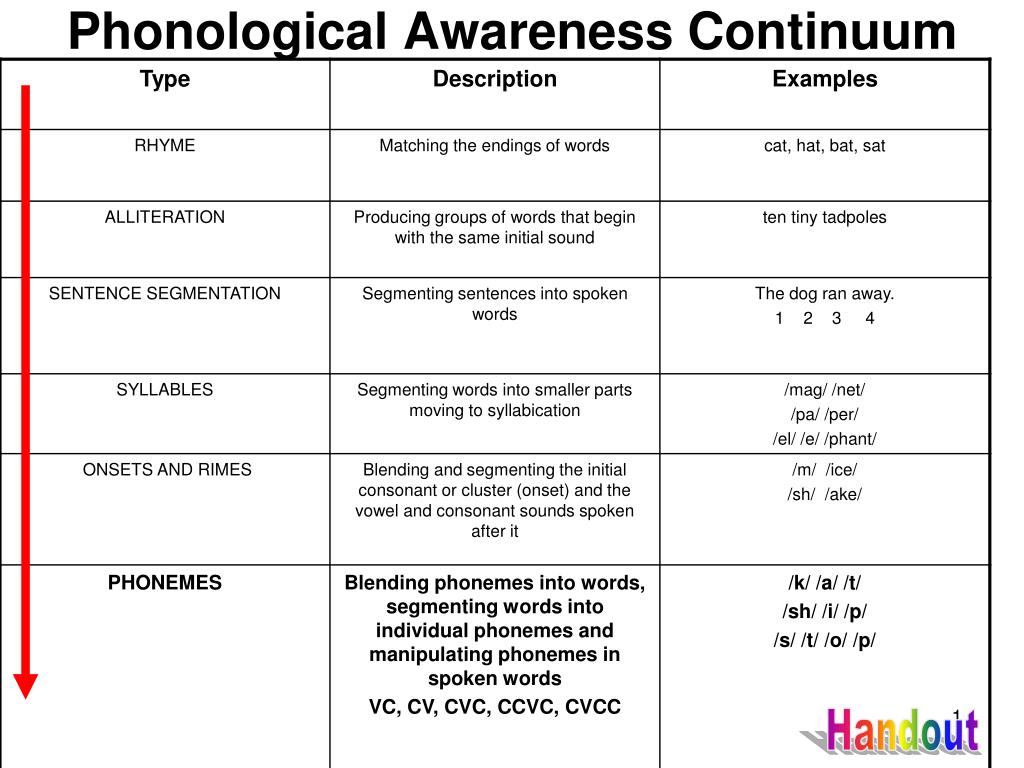 Check out YouTube for teaching videos, Pinterest for games and crafts, or the app store for nursery rhymes, sound games, and songs.
Check out YouTube for teaching videos, Pinterest for games and crafts, or the app store for nursery rhymes, sound games, and songs.
Whatever you do, keep the activities short and fun. If your child finds one activity too difficult or boring, try something different. If you find that activities of this type are too hard, talk to your classroom teacher. Your district’s early childhood department may also be able to help you get extra help.
Key takeaways
There are many ways to include sound play in your daily routine with your child.
Kids who play with sounds, syllables and rhymes when they are young are gaining important reading readiness skills.
If these skills are really difficult for your child, you may want to seek extra support in this area.
Related topics
Reading and writing
Strategies and tips
Examples to promote phonological awareness
This page has example activities to develop the major phonological awareness skills.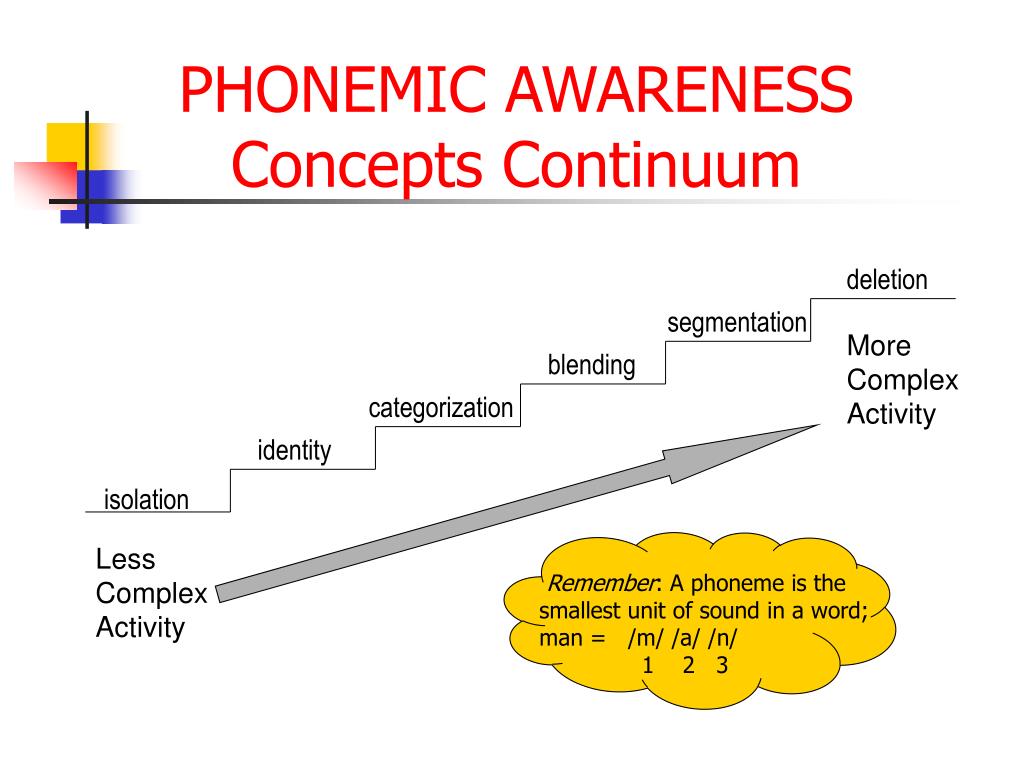 It is important to remember that phonological awareness activities do not have to occur with the written letters. Initially, working on phonological awareness takes place without the written word (using real objects, pictures, and counters for instance).
It is important to remember that phonological awareness activities do not have to occur with the written letters. Initially, working on phonological awareness takes place without the written word (using real objects, pictures, and counters for instance).
As phonological awareness activities develop it is important for students to participate in phonological awareness activities that link sounds (phonemes) to letter patterns (graphemes).
Allington et al. (1998) note the importance of using a range of resources purposefully such as nursery rhymes, riddles, songs, poems, and read-aloud books that manipulate sounds to draw young learners’ attention to the sounds of spoken language.
For example, using a familiar rhyme such as Five Little Monkeys provides a playful and meaningful context for young learners:
Five little monkeys jumping on the bed
One fell off and bumped his head
Mama called the doctor and the doctor said,
“No more monkeys jumping on the bed!”
Phonological awareness activities and lessons should broadly involve:
- Highlighting phonological awareness concepts in songs, rhymes, poems, stories, and written texts
- Finding patterns of rhyme, initial/final sound, onset/rime, consonants and vowels, by:
- Matching pictures to other pictures
- Matching pictures to sound-letter patterns (graphemes)
- Matching pictures to words
- Matching words to other words
- Using games to practise the awareness of syllables, rhyme, initial/final sound, and individual sounds in words.

The examples below provide some ways to incorporate phonological awareness into everyday classroom activities.
Example activities:
Syllable AwarenessStudents sit in a circle. Each student claps the syllables in their name e.g. Lu-cy (clap, clap)
This could also be done with claves, other forms of body percussion
Group time rhymes with movement, stamping feet for the beat or syllable - e.g. feet, feet, feet, feet, march-ing up and down the street
Mystery bag - fill with familiar objects, students pull out an object, name it, clap the syllables - e.g. 'lion' - li-on, 'ball' - ball, 'octopus' - oct-o-pus
Set up a t-chart on the carpet (could use string or masking tape), children choose an object from around the room to bring to the carpet and classify depending on the number of syllables e.g. the t-chart may have 1-syllable and 2+ syllables, children place their objects accordingly (hat in 1 syllable, pen-cil in 2+ syllable)
Foundation Level Lesson: Developing Syllable Awareness
Text: I Went Walking by Sue Williams and Julie Vivas
About the text: A little girl goes for a walk and meets a number of colourful farm animals along the way.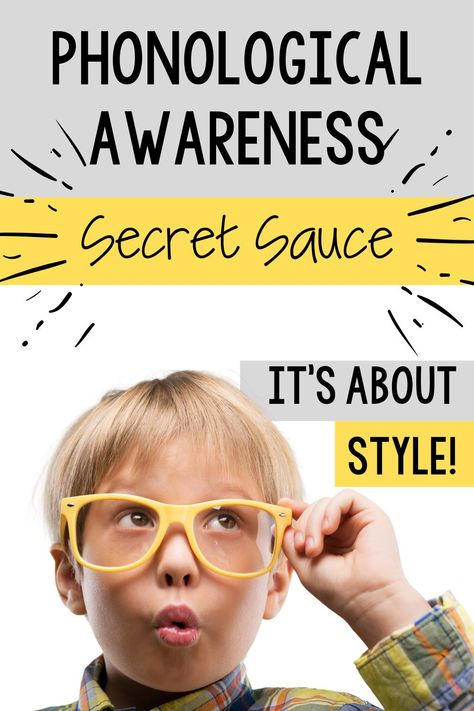
The text contains
- Repeated sentence structures
- Questions and answers
- Supporting text matching the illustrations
- Rhythm and rhyme
Links to the Curriculum
Victorian Curriculum (English), Reading and Viewing: Language-Expressing and developing ideas:
Foundation: Recognise that texts are made up of words and groups of words that make meaning (Content description VCELA144)
Victorian Curriculum (English), Reading and Viewing: Literacy-Interpreting, analysing, evaluating:
Foundation: Read texts with familiar structures and features, practising phrasing and fluency, and monitor meaning using concepts about print and emerging phonic, semantic, contextual and grammatical knowledge (Content description VCELY152)
Victorian Curriculum (English), Speaking and Listening: Language-Phonics and word knowledge:
Foundation: Identify rhyming words, alliteration patterns, syllables and some sounds (phonemes) in spoken words (Content description VCELA168)
Theory/practice connections
A component of phonology is syllable awareness.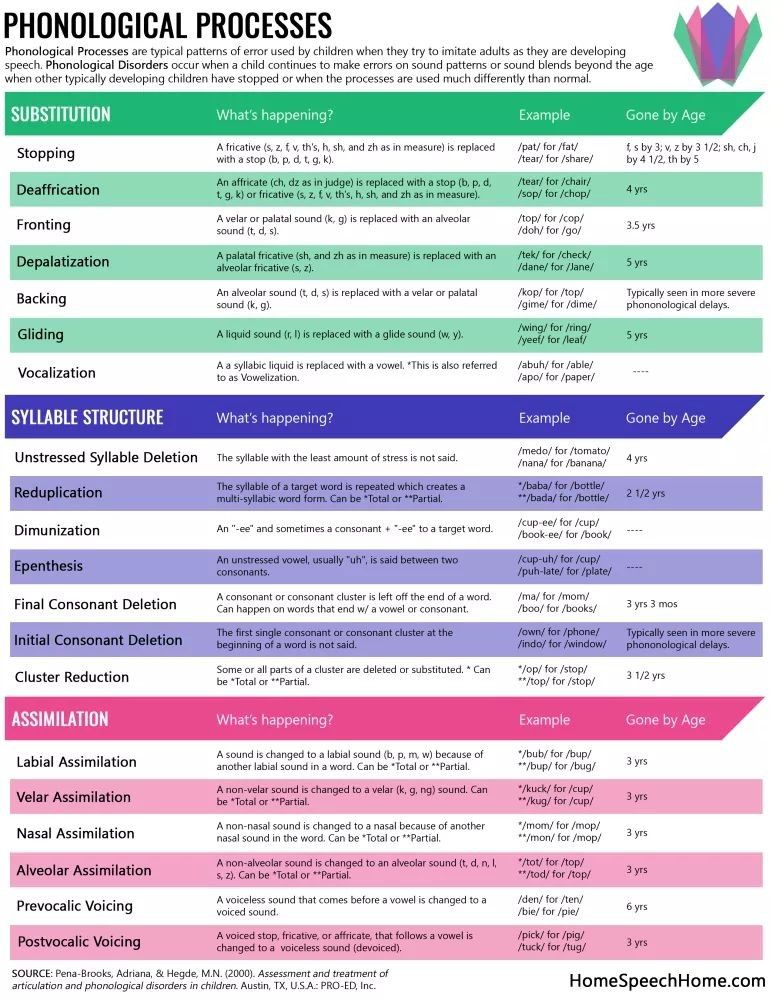 Understanding syllables, that is, understanding that words can be broken up into parts, helps students to decode words when reading and spell words when writing. Before focusing on syllables in print, it is important that students develop an auditory awareness of syllables. Children’s literature which has rhymes and repetition provides an engaging context for students to develop their skills in syllabification.
Understanding syllables, that is, understanding that words can be broken up into parts, helps students to decode words when reading and spell words when writing. Before focusing on syllables in print, it is important that students develop an auditory awareness of syllables. Children’s literature which has rhymes and repetition provides an engaging context for students to develop their skills in syllabification.
Additional resources
Objects and pictures for follow up work.
Learning Intentions
We are learning to identify the syllables in words.
Success Criteria
I can clap the rhythm of the text.
I can clap the syllables in words with one, two or three syllables.
I can classify words into groups according to the number of syllables.
Role of the Reader
Text decoder – applying syllabification knowledge to decoding text
Group Size
Small group
Lesson Process
- Read I Went Walking to the students, encouraging choral reading of the text.
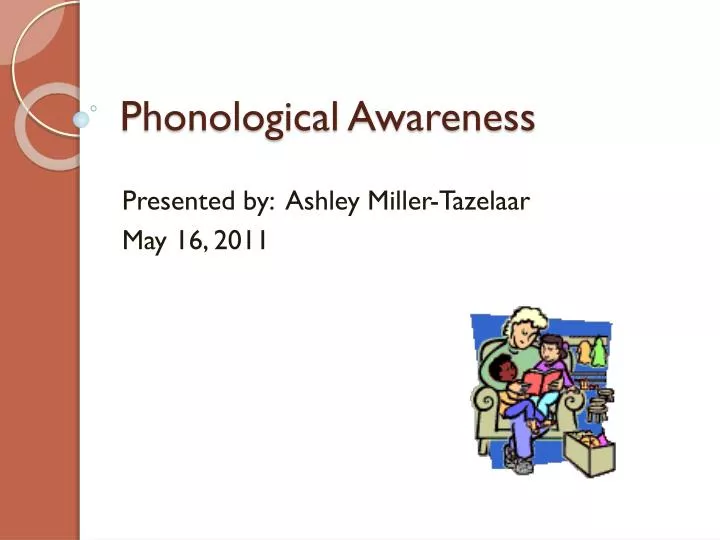
- Repeat the reading, encouraging students to read along and clap to the rhythm of the text.
- Have the text written on long sentence strips and use a pointer to highlight syllables. Students clap along to the rhythm and identify the words that have two claps (two syllables) – walking, looking, yellow
- Read again and use different body percussion for one and two syllable words.
- Read again and students use percussion instruments to highlight syllables.
- Students focus on the colour of the animals and find the colours that have two claps.
- Follow up activity: Students classify objects or pictures according to the number of syllables.
Assessment
Ask students to clap out parts of the text.
Differentiation
For beginning readers, syllables can be identified through claps and discussed as ‘the claps in words’. Once students are comfortable with the concept, the term syllables can be used.
Rhyme- rhyming card games
- sorting objects by rhyme
- storybooks with rhyme - e.
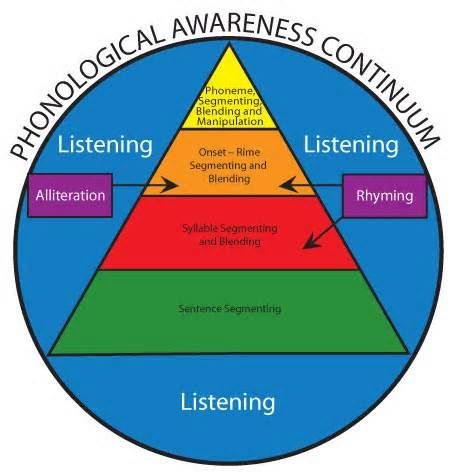 g. Hairy Maclary, Room on the Broom, The Gruffalo
g. Hairy Maclary, Room on the Broom, The Gruffalo - I have, who has? Students have a card/object, they need to find the other student in the class that has a card/object that rhymes with theirs - e.g. the student with a frog needs to find the student with a dog
- book with song - One Elephant Went Out To Play
- using songs with actions to highlight rhyming:
My hands a feeling chilly,
I think they're turning blue I need something to warm them up but what can I do?I can rub them, rub them, wriggle them around,
I can shake them, shake them and bang them on the ground.I can rub them, rub them, wriggle them around,
I can shake them, shake them and bang them on the ground.
For more information, see: In-Practice Example: Identifying and generating rhyming words
Alliteration- poetry reading - Kenn Nesbitt has some examples, also how to write poems using alliteration
- analysing a poem to find all the alliteration (this can be highlighted)
- book reading - e.
 g. Fox in Socks (Dr Seuss), Hairy Maclary
g. Fox in Socks (Dr Seuss), Hairy Maclary - making up own alliteration poems as a class/small groups
- using tongue-twisters
- using (and/or making) word wheels, recording the words made. This can be done individually on small whiteboards or posters in groups
- sorting words by rime - this could be done on the interactive whiteboard, students can move words into like groups, e.g. all the words ending in -at grouped together
- 'chunks' game - students choose an onset and rime, if it makes a real word they keep it, if it is a non-word it goes back in the pile. e.g. 'tr' and 'ack' = track - real word, 'cl' and 'at' = clat - non-word
- matching games with onset card and corresponding rime card (e.g. sparklebox resources)
- roll a word - onset (one dice), rime (second dice), read the word then write down under word/non-word
- word families
For more information, see: In-Practice Example: Blend and segment onset and rime
Initial and Final Sounds- sorting objects or pictures by the initial or final sounds
- bingo
- labelling initial sounds of objects in a drawing response
- word study - highlighting initial sounds and final sounds
Foundation lesson-Initial sounds
Text: I Went Walking by Sue Williams and Julie Vivas
About the text A little girl goes for a walk and meets a number of colourful farm animals along the way.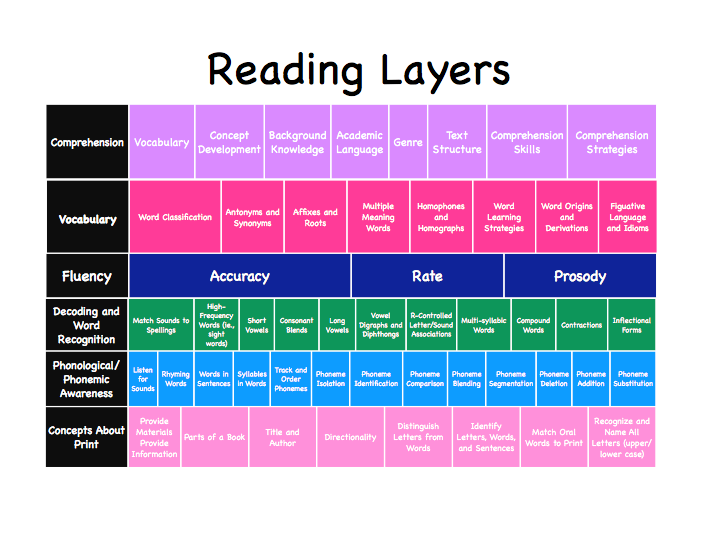
The text contains
- repeated sentence structures
- questions and answers
- supporting text matching the illustrations
- rhythm and rhyme
Links to the Curriculum
Victorian Curriculum (English), Reading and Viewing: Language
- Foundation Level: Recognise that texts are made up of words and groups of words that make meaning (Content description VCELA144)
- Recognise all upper- and lower-case letters and the most common sound that each letter represents (Content description VCELA146)
Victorian Curriculum (English), Reading and Viewing: Literacy
- Read texts with familiar structures and features, practising phrasing and fluency, and monitor meaning using concepts about print and emerging phonic, semantic, contextual and grammatical knowledge (Content description VCELY152)
Victorian Curriculum (English), Writing: Phonics and word knowledge
- Understand that spoken sounds and words can be written and know how to write some high-frequency words and other familiar words including their name (Content description VCELA157)
Victorian Curriculum (English), Speaking and Listening: Language
- Identify rhyming words, alliteration patterns, syllables and some sounds (phonemes) in spoken words (Content description VCELA168)
- Victorian Curriculum (English), Speaking and Listening: Literature Modify familiar texts (Content description VCELT173)
Theory/Practice connections
Repeated readings of text affords students the opportunity to address fluency, phrasing and expression. Reading a text multiple times, with early readers, allows students to focus on a particular aspect of literacy, within a familiar context. Repeated readings can occur individually, with a partner or in a group.
Reading a text multiple times, with early readers, allows students to focus on a particular aspect of literacy, within a familiar context. Repeated readings can occur individually, with a partner or in a group.
Additional resources
Cards with the colour adjectives and names of the animals written on them – Green duck, brown horse, red cow etc.
Learning Intention:
We are learning to use the first sound to help us read words.
Success Criteria:
I can identify the first sound of words.
I can make the first sound in words.
I can find words in text by looking at the first sound.
I can re-read a text to improve my fluency.
Role of the Reader
Text decoder – using phonological knowledge and phonics knowledge to decode texts.
Group Size
Small group
Lesson Sequence
- Read the text I Went Walking by Sue Williams and Julie Vivas.
- Students are given a set of cards with the names of the animals from the story written on them – black cat, red cow, yellow dog etc.
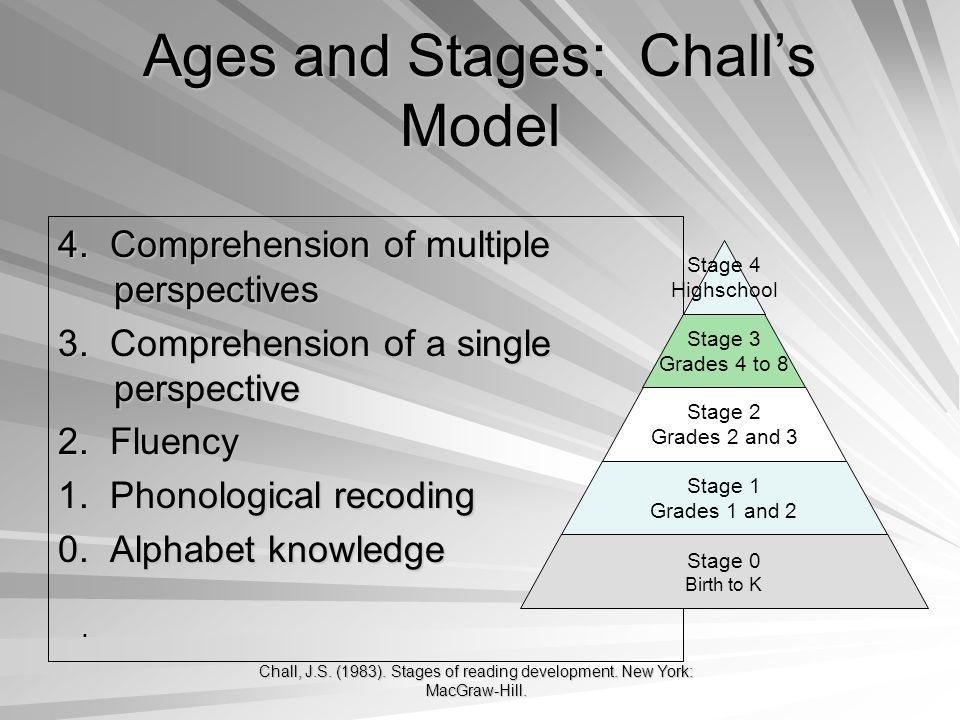 Re-read the text stopping at the name of the animals. Students find the animal name and colour from their card set.
Re-read the text stopping at the name of the animals. Students find the animal name and colour from their card set. - Encourage students to justify their reasoning for selecting a card. Assist students to focus on initial sounds.
- Assessment Provide students with a few sentences from the text, which have been cut up and re-arranged. Students use their knowledge of the text and the initial sounds of words to arrange the words into their correct order.
- Innovate on the text to create a group big book. Students illustrate and use for choral reading. Students use their developing knowledge of initial sounds to identify the words for the animal and its description.
Differentiation
More support for students who are not yet confident with phonics can be provided through illustrated alphabet cards. The teacher can encourage students to draw upon their phonemic awareness by asking comparison questions, and referring to the alphabet cards. For example: Does cow start with the same sound as car or moon, cow/car or cow/moon.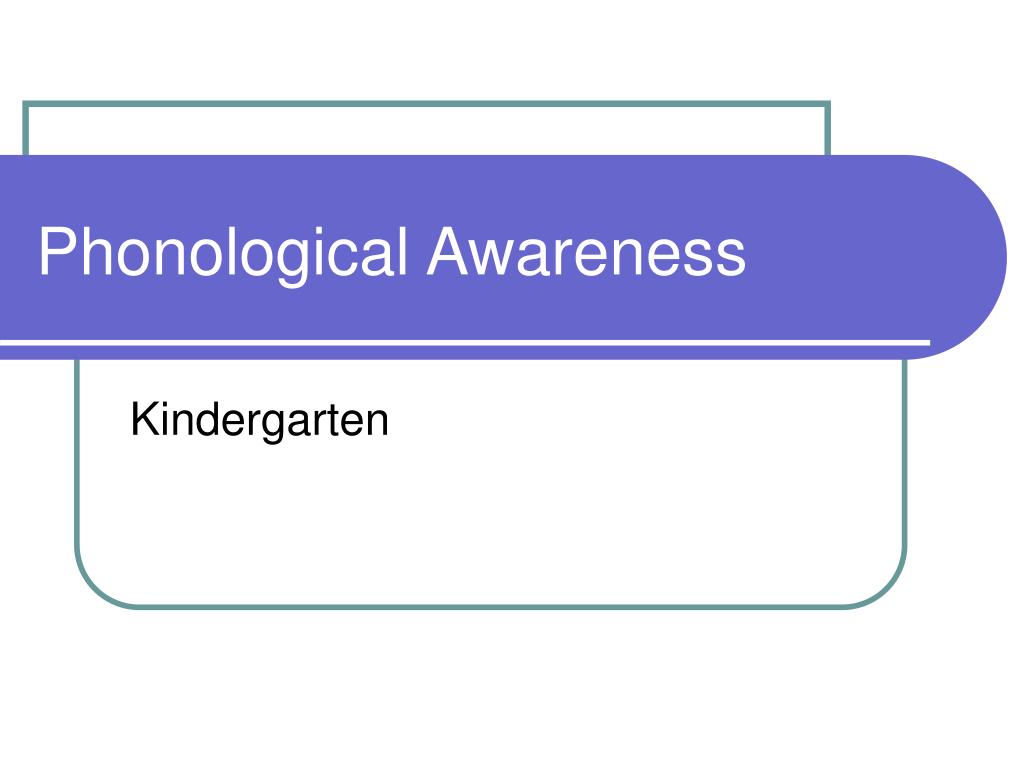
- interactive whiteboard - drag letters to form CVC words (this can be extended), children blend the sounds together to make a real word
- guess-the-word game
- segmenting - How many sounds can you hear? This can be recorded/graphed on paper and clip board
- using magnetic letters to pull words apart by sound, moving them around on a whiteboard, blending and segmenting
- using letter magnets to change words by deleting or manipulating letters - this could also be done on the whiteboard
In practice examples
- Level 1 alliteration (in in-practice examples section of the toolkit)
- Foundation level - Hearing and generating words that rhyme
15 Learning Disorder Terms Parents Need to Know
If your child has a speech, reading, or learning or attention disorder, you may have come across these terms on social media, forums, or at professional appointments.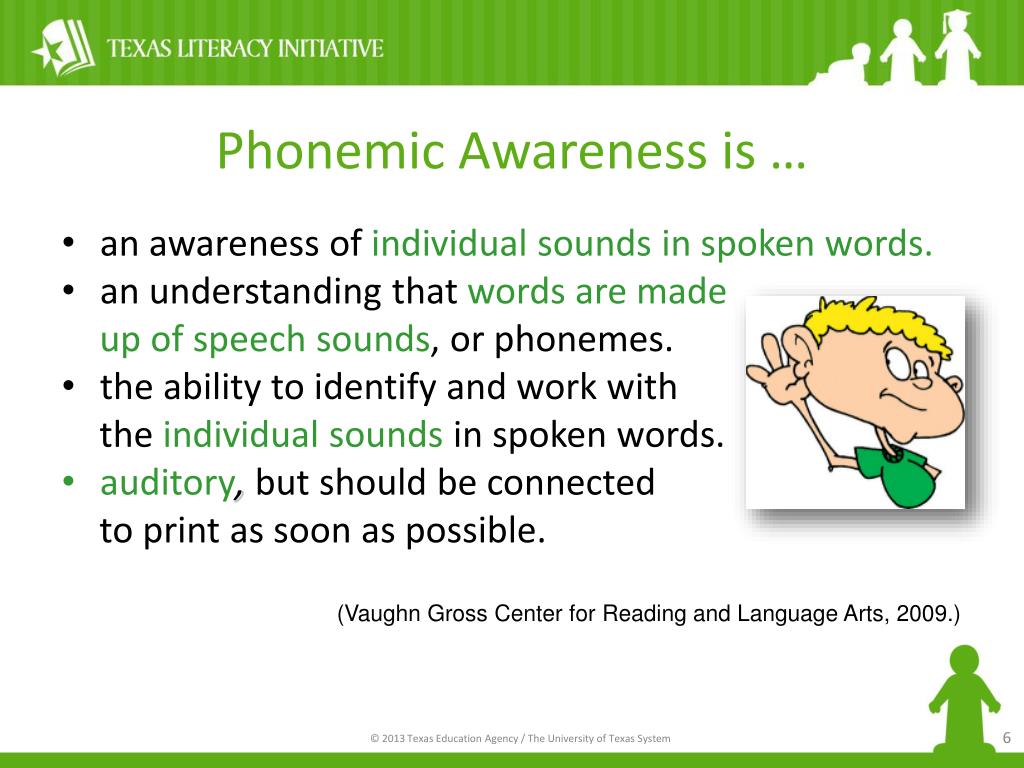 .
.
Terms such as phonological awareness, auditory processing disorder, auditory accuracy, phonological memory…
Understanding these 15 terms will help you better organize the help you need for your child:
1. Phonetics
Phonetics - this term refers to the sound structure of the language: the relationship between a letter or a combination of letters (for example: chi, shu, cha, yes) and the speech sounds they represent.
Phonetics is the foundation of reading and writing skills. Thanks to phonetics, the child decodes written words in the process of reading.
2. Phonemes
A phoneme is the sound of speech. When we speak Russian, we make 42 different speech sounds. But there are only 33 letters in the Russian alphabet. This is one of the reasons why Russian is difficult to learn.
3. Phonemic perception
Phonemic perception is the ability to perceive individual speech sounds (phonemes) in words and work with them.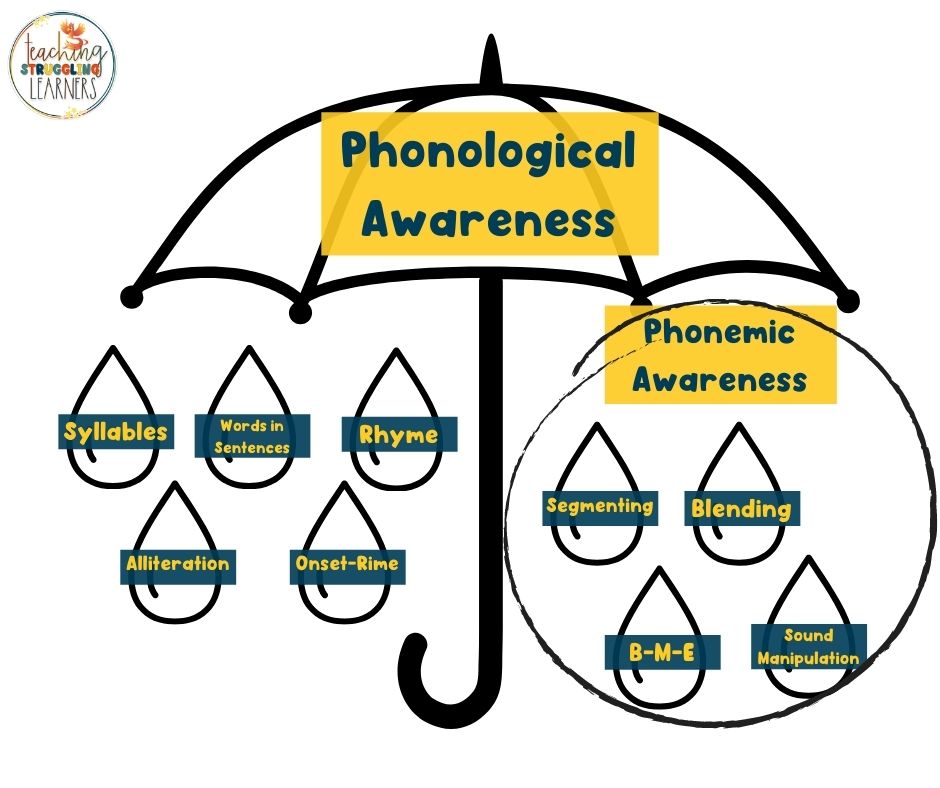
Learn how to develop phonemic awareness from an early age.
4. Phonological awareness
Phonological awareness is the awareness that words are made up of smaller parts (such as syllables and sounds).
The term includes a range of sound-related skills that a student needs to develop reading skills. As the child develops phonological awareness, he/she not only comes to understand that words are made up of small sound units (phonemes), but also learns that words can be broken down into larger sound "chunks" known as syllables. .
5. Phonological accuracy
Phonological accuracy refers to the ability to correctly distinguish between individual phonemes (e.g., in similar-sounding words that begin with the same sound) or other aspects of phonology (e.g., rhyming, number of syllables).
Phonological accuracy is key to listening and reading skills.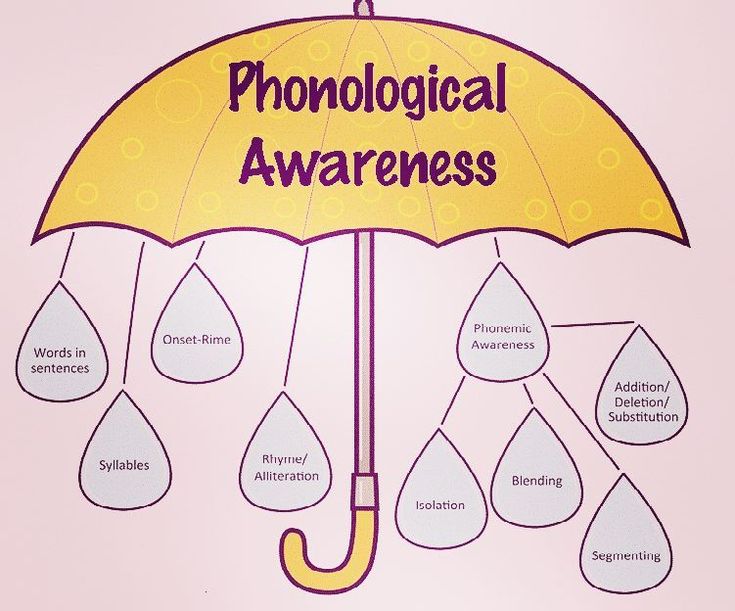 This allows the student to make a clear distinction between similar-sounding words (e.g. "heron" and "saber" or "picture" and "basket"), including morphological differences that can drastically change the word's meaning and/or grammatical function (e.g. " known" and "unknown" or "inserted" and "exposed").
This allows the student to make a clear distinction between similar-sounding words (e.g. "heron" and "saber" or "picture" and "basket"), including morphological differences that can drastically change the word's meaning and/or grammatical function (e.g. " known" and "unknown" or "inserted" and "exposed").
The ability to quickly and accurately identify speech sounds is critical to learning the rules of phonetics and matching spoken language to text correctly.
A child with well-developed phonological accuracy will more easily develop decoding skills, understand word and sentence structure, develop vocabulary, follow instructions, and participate more actively in class work.
Well developed phonological precision helps in:
-
Understanding and following verbal instructions
-
Listening skills
-
Development of reading skills
-
Learning the rules of phonetics
6.
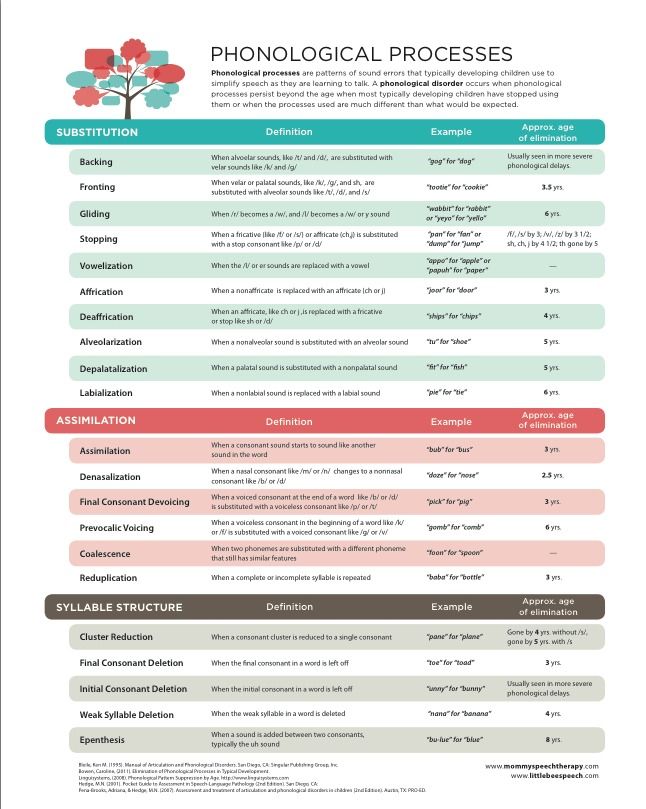 Phonological fluency
Phonological fluency
Phonological fluency is the understanding that words are made up of different sounds and the ability to quickly and accurately identify and manipulate these sounds.
Phonological fluency is critical to learning to read. This allows the student to memorize sequences of sounds and manipulate them quickly and accurately. This makes it easier to both write words and decode them. The more effectively the reader is able to decode, the more of his cognitive resources (mental abilities) he can focus on understanding the text.
A student with good phonological fluency will also find it easier to learn new words while reading. When confronted with a new word, a student who can accurately pronounce the word is more likely to recognize and understand its meaning.
Well-developed phonological fluency helps in:
-
Learning the rules of phonetics
-
Development of reading skills
-
Development of writing skills
7.
 Phonological memory
Phonological memory
Phonological memory is the ability to retain speech sounds in memory. This is essential for spoken language and tasks such as comparing phonemes and making connections between phonemes and letters. It also helps with listening and reading understanding of sentences, as it allows you to remember the sequence of words in order.
Phonological memory plays a key role in the development of oral and written language skills. This allows the student to:
-
Memorize and manipulate sound sequences
-
Associate spoken words with written ones
-
Memorize new words by determining their meanings
-
Remember the beginning of a sentence by listening to it to the end.
The ability to remember speech sounds is important for the correct understanding of sentences when changing the order of words in a sentence changes its meaning (for example, "The monkey bites the boy" and "The boy bites the monkey").
Accurate memory of word order also contributes to building accurate ideas about sentence structure and acquiring knowledge of syntax.
A student with a well-developed phonological memory develops phonemic perception and decoding skills more easily, knowledge of vocabulary and sentence structure is formed. Such a student follows instructions better and takes a more active part in class work with presentations, etc.
8. Auditory Processing / Auditory Perception
Auditory processing refers to what the brain does with the audio information it "hears". This includes various skills such as identifying and locating sounds, listening to background noise, and processing what is heard when the sound is fuzzy.
When a student manipulates the auditory information he has heard, but it doesn't sound right, this is called an auditory processing disorder (or auditory perception disorder).
This can happen if the child has difficulty understanding speech in background noise or has difficulty identifying where the sound is coming from.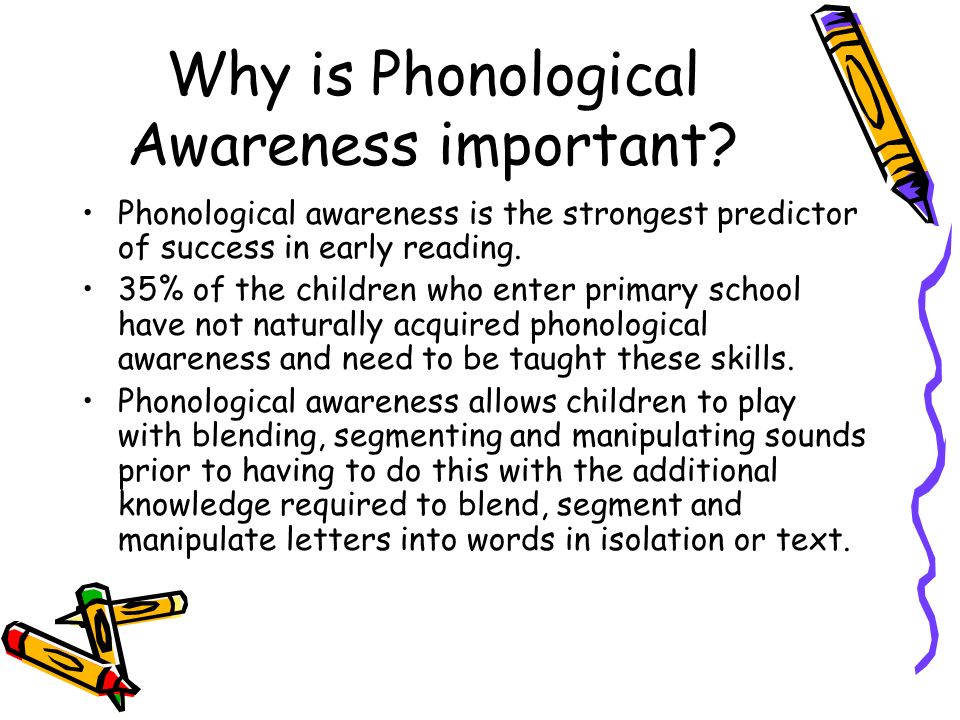 Or it could be a problem in distinguishing speech sounds that sound similar.
Or it could be a problem in distinguishing speech sounds that sound similar.
Find out 5 common hearing loss (HAI) myths!
9. Sequencing of audio information
Sequencing of audio information refers to the ability to identify and remember the order in which a series of sounds were presented. This is very important for matching sound sequences to letter sequences in decoding and writing.
Organizing audio information is critical to developing speaking and writing skills. The ability to identify and remember the order of sounds in words is important for recognizing subtle differences between words (such as "pot" and "top") and for developing phonemic perception and decoding skills.
A student who has a well-developed ordering of sound information understands and absorbs information better, develops better oral and written speech skills and concentrates attention. Such a student becomes an expert reader and a successful student.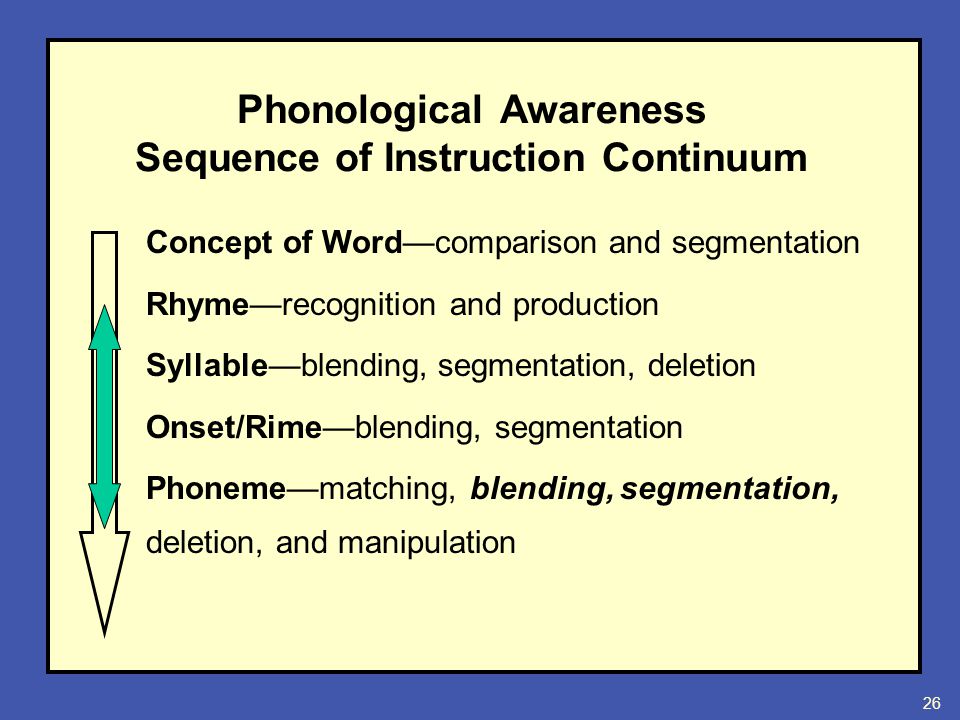
See also: How do weak cognitive skills affect learning?
10. Listening word comprehension
Listening word comprehension refers to the ability to accurately identify words heard based on auditory cues alone, without the aid of visual or contextual cues.
Listening comprehension of words is critical to the development of spoken language and vocabulary, and therefore essential to the development of reading and writing. This skill allows the student to accurately and efficiently identify words in speech and helps him form a correct understanding of the information presented by ear.
A student with well developed listening comprehension will find it easier to follow instructions and participate in class discussions; it is easier to answer questions, complete tasks and remember information; and it's much easier to become a proficient reader.
He will also find it easier to carry on a conversation in a noisy environment or when there are distractions.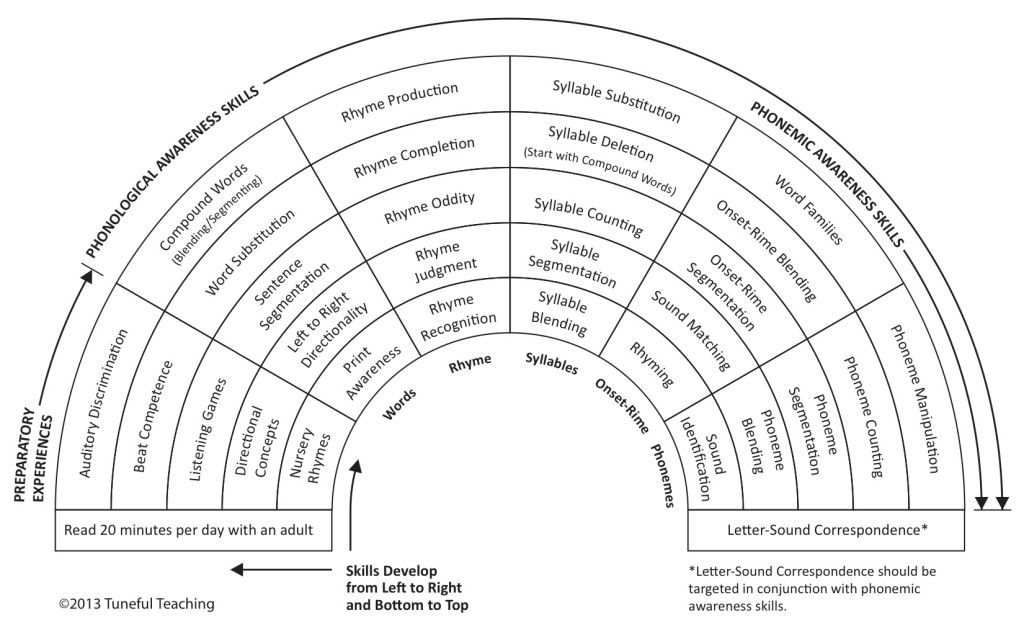
11. Hearing accuracy
Hearing accuracy is the ability to accurately identify differences between sounds and correctly identify sound sequences.
Accuracy in listening is the foundation of speech and reading skills. This skill allows the student to quickly and accurately identify and distinguish between rapidly changing sounds, which is very important for distinguishing between phonemes (the smallest units of speech that distinguish one word from another).
A student with well-developed listening comprehension will find it much easier to follow instructions and participate in class work; it is easier to remember questions, tasks and information; and it's much easier to become a proficient reader. He will also be able to:
-
Read and write fast
-
Focus on verbally presented information
-
Maintain a conversation in a noisy environment or when there are distractions.

12. Listening comprehension
Listening comprehension is the ability to understand consecutive sentences and extract meaning from what is heard.
Listening comprehension is one of the foundations of oral and written speech. To develop more complex speech skills, a child needs to develop good listening comprehension. Well developed listening comprehension allows the student to recognize the meanings formed by combinations of words and series of sentences.
A student with good listening comprehension will find it much easier to respond to assignments and class discussions; it will be easier to answer questions and remember information; and it is easier to become a proficient reader and a successful learner. He will also be able to do well:
-
Focus on oral information
-
Making sense of history
-
Correctly follow verbal instructions
-
Correctly understand and answer questions
Development of phonemic perception in ontogeny
WHAT IS PHONEMATIC PERCEPTION?
Phonemic perception is the ability to perceive words through the perception of sounds, determine how many sounds and syllables are in a word, which consonant is at the end of the word, and which is in front, which vowel is in the middle, etc.
Sometimes parents come to see a specialist and say, "My child has porridge in his mouth." This is how the speech of a child who has problems with phonemic perception is perceived.
When phonemic perception is formed correctly, the child will also pronounce sounds and words correctly, the pronunciation will be clear and precise, he can easily learn to read and write, learn the grammatical speech structure.
The foundation of the development of phonemic perception is the correct development of listening comprehension. Therefore, children who have problems with phonemic perception suffer from impaired auditory functions.
The child's vocabulary is not updated with new words that contain sounds that are difficult to distinguish. It follows that the grammatical structure of speech is not formed.
In this regard, the child lags behind his peers in development.
In this article we will talk about age norms in ontogeny and the stages of assimilation of the phoneme of a language.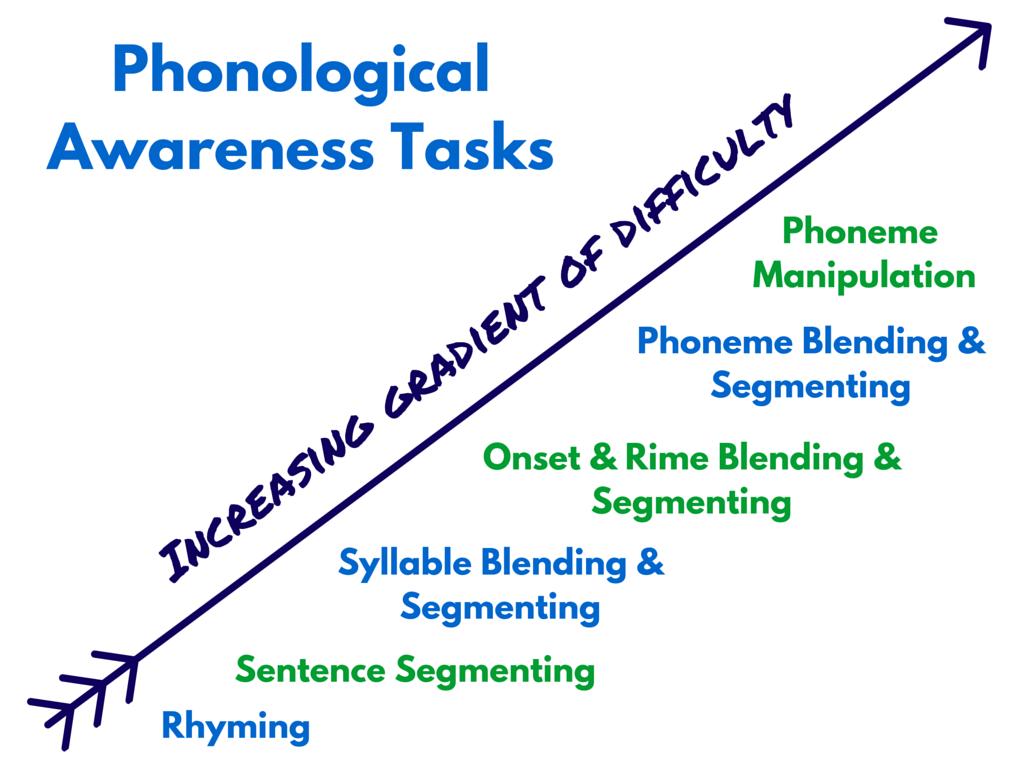
LEVELS OF SPEECH PERCEPTION
Speaking of phonetics, there are two levels of speech perception.
| Phonemic (sensory-motor) level | Phonological (language) level |
| This is the ability to distinguish speech sounds by ear and produce them with the help of articulation. In fact, this is a general speech sound. |
Phoneme-level speech recognition. The ability to determine the sound sequence and the number of sounds in a word.
|
The speech that a child hears is a rather difficult and unstable sound process. The task of the child is to find sounds and sound combinations with which you can distinguish the meaning of what was said.
But also the child must be able to generalize the sounds of speech, this is called the semantic role of language.
ONTOGENETIC FEATURES OF THE DEVELOPMENT OF PHONEMATIC PERCEPTION
In ontogeny, phonemic hearing occurs spontaneously and at a very early age.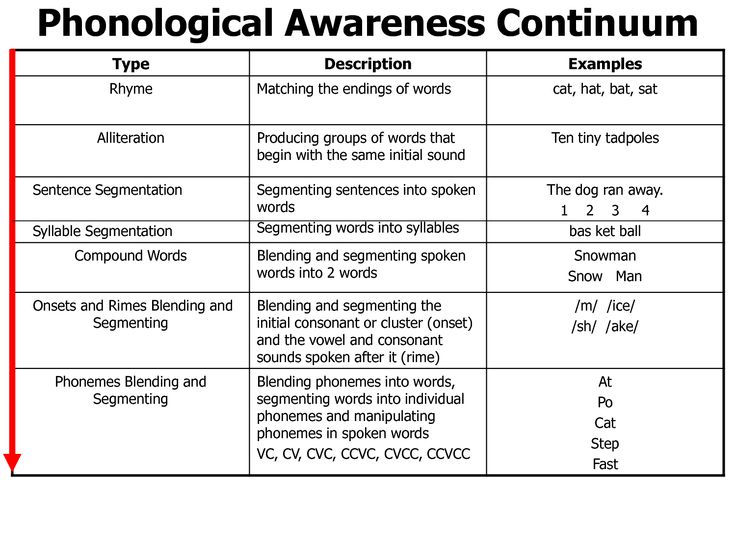
When a baby is two weeks old, hearing a noise or someone's voice, he stops crying, calms down or is distracted from the process of feeding.
In the table below I will talk about the age norms for the development of phonemic perception.
| Pre-phonemic stage of speech development (speech comprehension is not developed) | |
| Embryonic development |
Ability to perceive speech sounds begins to be laid.
|
| 1-2 months |
The child reacts to external noise vibrations: rattle, voices, melodies, etc.
|
| 2-3 months |
The child begins to look for where the sound comes from: turn his head, turn over in the right direction.
|
| 3-6 months |
The child already finds sources of sound with his eyes, can distinguish between voices, determines the intonation of the voice (affectionate or strict).
|
| Phonemic stage (linguistic) | |
| 6-7 months |
The kid no longer just hears different sounds, but learns to perceive the speech he hears. A large semantic role in this period is assigned to rhythm recognition skills.
|
| 7-8 months |
The child understands many words, including the names of the objects he sees.
|
| 9-12 months |
Along with the recognition of intonation and rhythms, the child begins to extract the sound pattern that forms a word.
|
| 2 years |
At this age, the child understands and can distinguish words that differ in only one phoneme, for example, “Rosa-kosa”. The child develops the perception of speech sounds.
|
| 3 years |
The child is able to distinguish between vowels and consonants, hissing / whistling, soft / hard, sonorous (voiced consonants with minimal noise)
|
| 4 years |
The child distinguishes all sounds.
|
| Final steps | |
| 5 years |
Spontaneous phonemic development ends. The child is able to distinguish images of objects and sounds separately.
|
| 6-7 years |
Full awareness of the sound side of words comes
|
The very phonemic perception of sounds is formed as a result of the mutual connection of auditory and kinesthetic vibrations that enter the cerebral cortex.
PSYCHOLOGICAL FEATURES OF PHONEMS
Psychological features of the development of a phoneme are strongly associated with the development of the phonemic side of a child's speech. I propose to get acquainted with the main ones:
- Phonemic generalization.
A phoneme arises when a word is formed.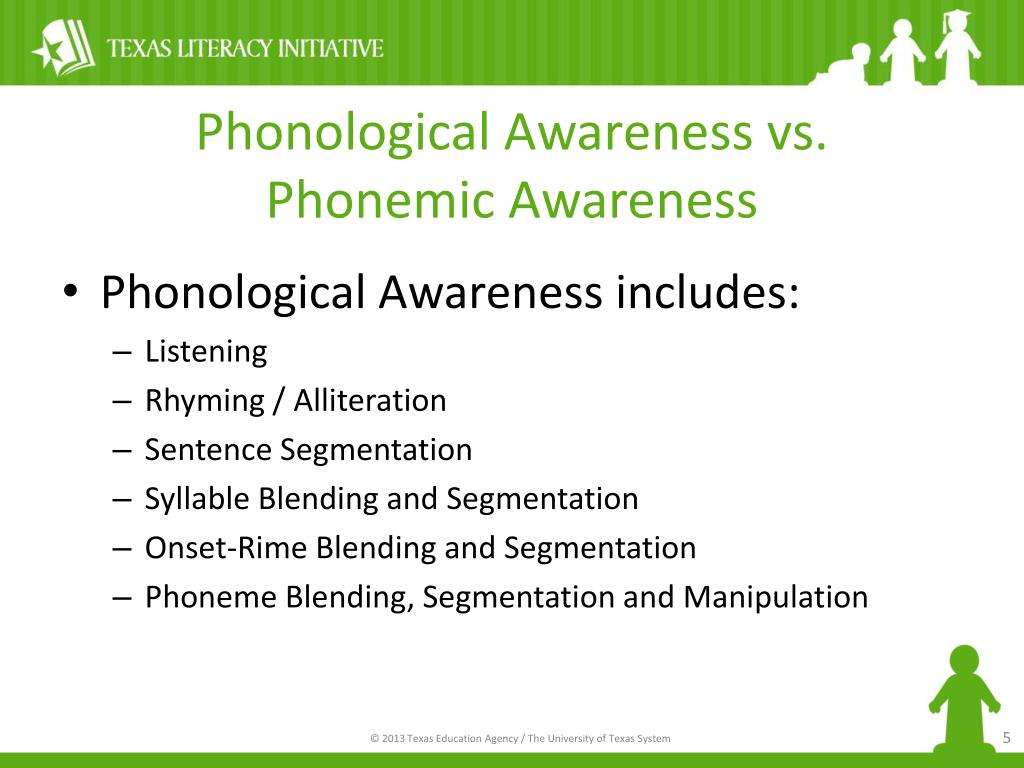 The phoneme of a language is a set of phonetic representations that draw a specific image in the process of speech.
The phoneme of a language is a set of phonetic representations that draw a specific image in the process of speech.
- Distinctive phonemic function.
A phoneme is a sound that helps to recognize a word. The psychological feature of the distinctive function is formed when the phoneme appears
- Phoneme constancy.
In other words, constancy is immutability, constancy. It allows you to correctly perceive the same sound in different words. For example, the sound “T”, in the words “current” and “cat”, we perceive it the same way.
- Arbitrary qualities of a phoneme.
We make sounds either voluntarily or intentionally. Arbitrary qualities are formed precisely at the time of the appearance of sound. While the phoneme of the language is not developed in the child, he pronounces sounds involuntarily and these sounds are accompanied by articulation.
As you understand, the formation and development of phonemic perception is a long process.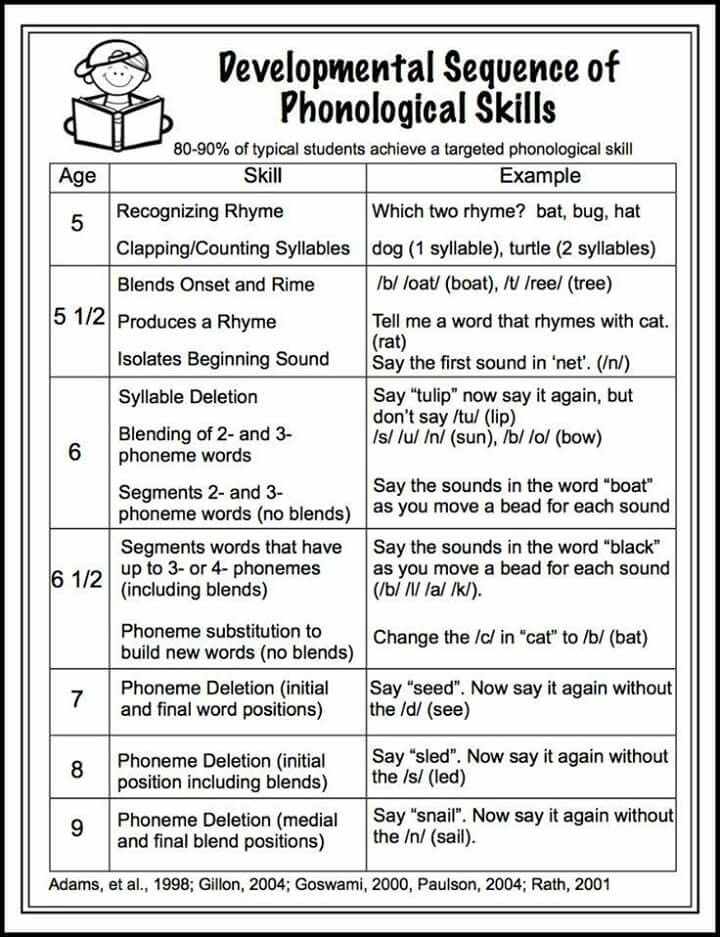

 Reacts differently to calm and active melodies
Reacts differently to calm and active melodies  At this age, the formation of phonemic perception and pronunciation of sounds continues.
At this age, the formation of phonemic perception and pronunciation of sounds continues. 